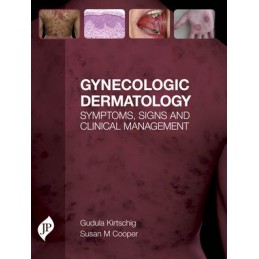- Reduced price

Order to parcel locker

easy pay


 Delivery policy
Delivery policy
Choose Paczkomat Inpost, Orlen Paczka, DHL, DPD or Poczta Polska. Click for more details
 Security policy
Security policy
Pay with a quick bank transfer, payment card or cash on delivery. Click for more details
 Return policy
Return policy
If you are a consumer, you can return the goods within 14 days. Click for more details
Vulval diseases are managed by dermatologists and by ObGyns and while expert referral centres do exist, the majority of patients are treated by non-specialists. These conditions are relatively common (approximately 15% of a gynaecologists caseload) and can be difficult to diagnose.
Gynecologic Dermatology is a practical, highly illustrated guide written with the needs of the general dermatologist or gynaecologist in mind. The book begins with chapters on normal anatomy; history taking and examination of the vulva; biopsy taking and general management options. Next, symptom-based chapters describe presenting problems such as pruritus, broken skin and scarring, using flowcharts to help the physician work through to a diagnosis. Finally, chapters devoted to key conditions (lichen sclerosus, lichen planus, etc) describe the pathogenesis, clinical presentation, differential diagnosis and management of the disease in question.
Abundantly illustrated and written in a practical, clinically oriented style, Gynecologic Dermatology is an indispensable reference for non-specialists that bridges the gap between dermatology and gynaecology.
Data sheet
1 Normal vulva
2 Normal histology of vulva and anogenital area
3 Vulvovaginal care
4 Taking a vulvar history and examination of the vulva
5 Scoring and recording of vulval disease
6 How to take a vulvar biopsy and what to expect from a histopathological examination
7 General treatment considerations
8 Pruritus
9 Pain
10 Red skin
11 Broken skin
12 White skin
13 Pigmented skin
14 Scarring
15 Swollen vulva
16 Atopic eczema, lichen simplex and seborrheic dermatitis
17 Contact dermatitis, fixed drug eruption and immediate hypersensitivity reactions
18 Erythema multiforme majus, Stevens-Johnson syndrome, toxic epidermal necrolysis and graft-versus-host disease
19 Lichen sclerosus
20 Lichen planus
21 Plasma cell vulvitis
22 Vulvar psoriasis
23 Hidradenitis suppurativa
24 Granulomatous conditions of the vulva
25 Scleroderma, systemic lupus erythematosus and Sjögren syndrome
26 Autoimmune bullous diseases
27 Inherited bullous diseases
28 Vulval ulcers
29 Primary bacterial and fungal vulval and vulvovaginal infections
30 Viral diseases
31 Sexually transmitted diseases
32 Cysts and diseases of the glands
33 Solid benign tumours
34 Benign and malignant pigmented lesions of the vulva
35 Malignant and pre-malignant non-pigmented tumours
36 Extramammary Paget disease of the vulva
37 Vascular disease
38 Vulvodynia
39 Psychological and sexological aspects
40 Vulval cosmetic surgery
41 Vulval body art
42 Vulval disease in children
Reference: 91639
Author: Kari Bo
Bridging Science and Clinical Practice
Reference: 93110
Author: Ali Azadi
